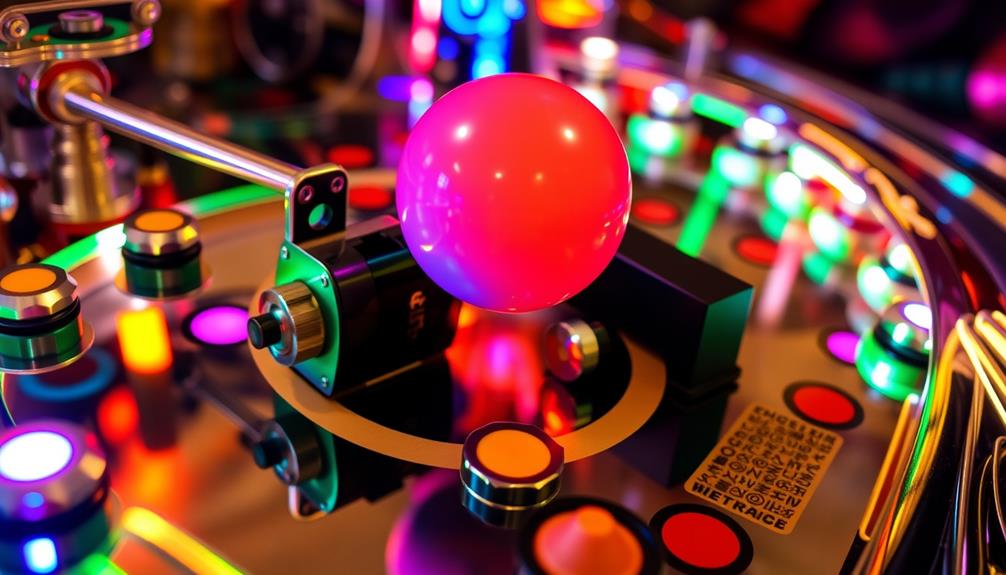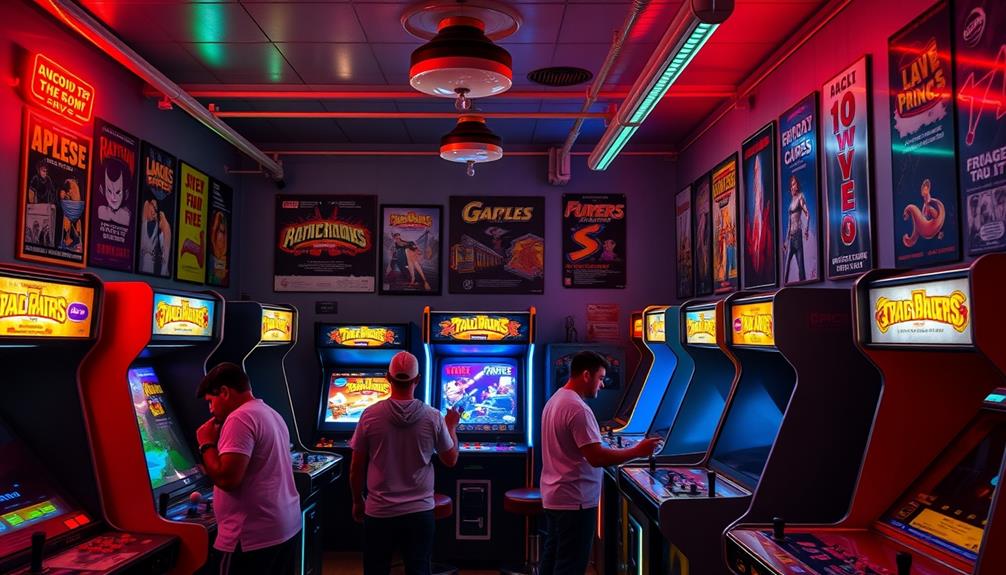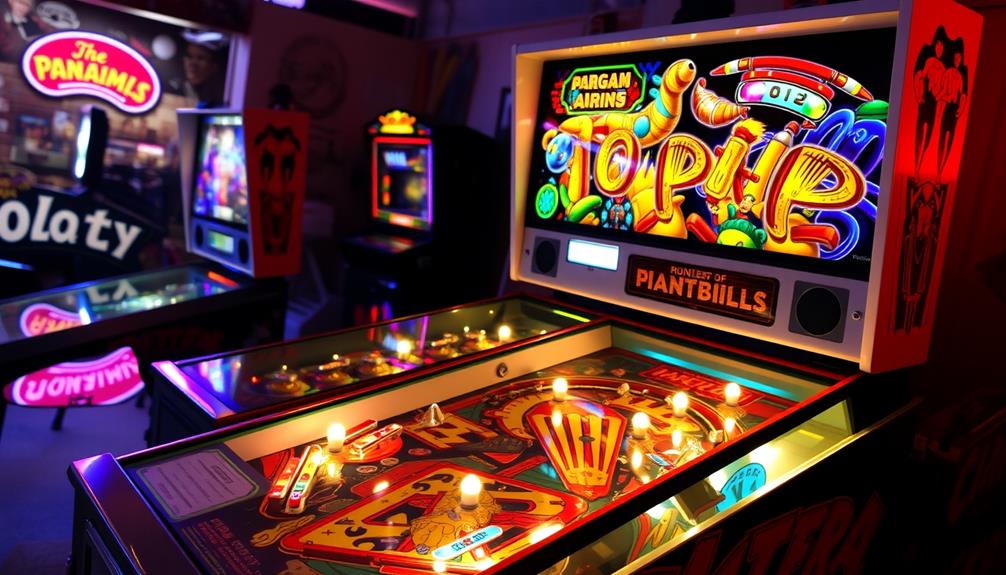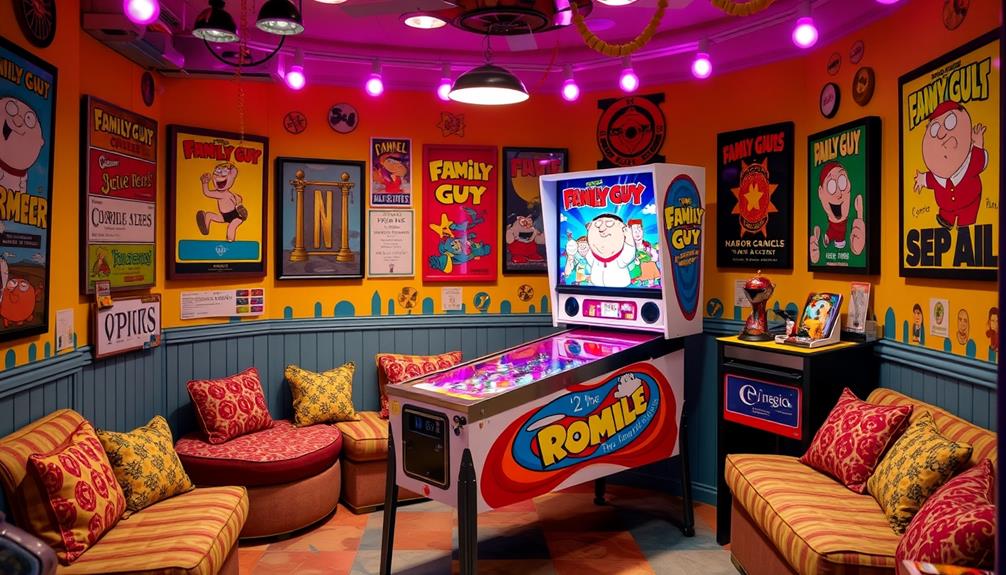Pinball machines were prohibited in California from 1939 to 1974. The state implemented the ban citing concerns about gambling and its potential impact on public morals. This legislation caused pinball to go underground, sparking a counterculture among fans. It wasn’t until a historic ruling by the California Supreme Court in June 1974 that pinball was officially recognized as a game of skill, leading to its eventual legalization. This shift not only revolutionized the entertainment industry but also changed the public’s perception of pinball as a nostalgic and skill-based hobby, paving the way for its modern comeback. Interested in learning more about this intriguing history?
Key Takeaways
- Pinball machines were declared illegal in California in 1939 due to concerns about gambling.
- The ban remained in effect for 35 years until it was repealed in 1974.
- The California Supreme Court ruled on June 22, 1974, recognizing pinball as a game of skill.
- Public sentiment shifted significantly after the 1974 ruling, leading to the resurgence of pinball culture.
- Pinball machines became legal again following the court's decision, allowing for their commercial revival.
Historical Context of the Ban
In 1939, pinball machines became a target of public scrutiny in California, particularly in Los Angeles, due to rising concerns over gambling and morality. Residents viewed these machines as a public nuisance, leading to the enactment of a ban following a majority vote on Proposition No. 3. With 161,000 votes supporting the proposition, pinball and other coin-operated machines were deemed harmful to society.
This ban reflected broader societal fears about gambling's influence and its potential to corrupt public morals. Similar to the emotional instability seen in individuals with BPD, the reactions to pinball machines highlight how societal concerns can create waves of fear and regulation.
For 35 years, the legal status of pinball machines remained unchanged, mirroring the prevailing attitudes toward gambling during that era. However, as public perceptions began to shift, advocates for pinball argued that it was primarily a game of skill rather than a form of gambling.
This perspective gained traction, culminating in a pivotal decision by the California Supreme Court on June 22, 1974. The court ruled against the ban, recognizing pinball as a legitimate game of skill.
This landmark ruling paved the way for the legalization of pinball machines and coincided with a resurgence in arcade culture, reflecting changing attitudes towards recreational activities and gambling in California.
Legal Implications of the Ordinance

The legal implications of the 1939 ordinance prohibiting pinball machines were significant, as they not only shaped the landscape of gaming in California but also influenced broader regulatory practices. By declaring pinball machines illegal, the ordinance allowed law enforcement to seize these devices, which were categorized as public nuisances. This created an environment where gaming devices were heavily scrutinized and regulated.
| Year | Event | Outcome |
|---|---|---|
| 1939 | Proposition 3 passed | Pinball machines declared illegal |
| 1940-1974 | Machines seized | Continued prohibition enforced |
| 1974 | California Supreme Court ruling | Pinball recognized as a game of skill |
| 1974 | Legalization of pinball | Shift in public perception |
| Post-1974 | Influence on arcade regulations | Set precedent for future gaming laws |
The California Supreme Court's ruling in 1974 not only overturned the ordinance but also established a critical distinction between games of skill and chance. This landmark decision marked a turning point, leading to the eventual acceptance of pinball machines and paving the way for future regulations on gaming devices.
Cultural Impact of the Ban

The ban on pinball machines in California pushed gaming underground, reshaping the entertainment landscape you know today.
This underground movement fostered a sense of community among players and sparked innovative gaming experiences, reminiscent of how primitive weapons for modern survival emphasize resourcefulness.
As enthusiasts sought out hidden spots to play, alternative gaming scenes emerged, reflecting a vibrant counterculture.
This shift not only showcased resilience but also laid the groundwork for the modern appreciation of arcade games.
Underground Gaming Scenes
A vibrant underground gaming scene emerged in California as enthusiasts defied the ban on pinball machines, transforming hidden locations into secretive parlors. These spots buzzed with excitement, creating a sense of rebellion against the legal restrictions that sought to limit their passion.
Players, driven by their love for the game, often pooled resources to share machines, showcasing a spirit of financial collaboration that mirrored investment strategies. In these clandestine venues, camaraderie among fellow players flourished, sharing tips and techniques that enhanced everyone's skills. The thrill of playing in defiance of the law added an electrifying layer to the experience.
This underground culture sparked innovation, as players developed new strategies and creative approaches to the games, pushing their limits in informal settings.
As time went on, the demand for these hidden gaming spots grew, demonstrating the resilience and determination of pinball enthusiasts. Finally, in 1974, the repeal of the ban allowed these underground gaming scenes to flourish openly.
This shift not only legitimized pinball but also paved the way for a vibrant arcade culture, forever changing the landscape of gaming in California.
Shifted Entertainment Landscape
During the years of the ban on pinball machines in California, the entertainment landscape underwent a significant transformation. This prohibition, rooted in concerns over gambling and morality, led to a noticeable decline in arcades and gaming businesses.
As the entertainment industry pivoted towards alternative forms of amusement, you'd find fewer options to enjoy recreational activities. The shift in public interests also mirrored trends in home entertainment, as families sought more engaging experiences together, akin to the rise of modern farmhouse decor trends that emphasize communal spaces for gathering.
Public sentiment shifted over the years, and by 1974, the repeal of the ban marked a cultural change that embraced arcade games as acceptable entertainment. The rise of underground gaming scenes revealed the tenacity of pinball enthusiasts, who continued to seek out machines despite the legal restrictions.
This underground culture not only kept the spirit of pinball alive but also set the stage for its eventual resurgence.
The legacy of the ban has had lasting effects on modern attitudes toward arcade gaming. Today, you can see a revival in California, with the emergence of arcade bars and a renewed interest in pinball culture.
The shift in public perception has transformed pinball from a banned activity into a beloved pastime, showcasing the resilience of the entertainment industry and the evolving nature of recreational choices.
Notable Events Surrounding the Ban

Notable Events Surrounding the Ban
Debate surrounding the ban on pinball machines in Los Angeles in 1939 highlights the tension between entertainment and societal norms. The ban, which passed with 161,000 votes in favor, reflected growing concerns about gambling and the perception of pinball machines as public nuisances.
As with many societal changes, this situation mirrored the need for open dialogues around evolving community standards. At a city council meeting on October 23, 1939, around 400 citizens gathered to express their views, illustrating the strong divide in public opinion. Some saw pinball as harmless fun, while others viewed it as a threat to community values.
Despite the ban, enforcement proved challenging due to the machines' popularity. Police were tasked with seizing the machines deemed nuisances, but many establishments continued to operate them.
Years later, the California Supreme Court stepped in. In June 1974, the court ruled that pinball was a game of skill rather than chance, fundamentally changing its legal status. This ruling paved the way for the legalization of pinball machines, marking a pivotal moment in gaming history.
The repeal coincided with a shift in public perception, embracing modern gaming culture and accepting pinball as a legitimate form of entertainment.
Legacy and Modern Relevance

You can see how the legalization of pinball machines in 1974 sparked a cultural shift in California, transforming them from a banned activity to a beloved pastime.
This revival not only reignited arcade culture but also influenced the gaming industry, leading to innovative designs and technology in modern machines.
The resurgence of such recreational activities resonates with the importance of maintaining leisure and entertainment options, much like diverse tent camping locations in New England that attract outdoor enthusiasts.
Understanding this legacy helps you appreciate how far pinball has come and its lasting impact on entertainment today.
Cultural Shift in Perception
Pinball machines, once shunned and banned in California, have undergone a remarkable transformation in public perception since the mid-20th century. The ban, particularly in Los Angeles, lasted from 1939 until 1974, but as attitudes shifted, the game began to be recognized for its skill rather than just luck.
This change in public perception paved the way for pinball's resurgence during the late 1970s, much like the evolution seen in AI-powered entertainment that enhances user engagement through innovative technologies.
One pivotal moment was Roger Sharpe's demonstration in 1976, where he showcased the skill involved in playing pinball, helping to change both public and legislative views. By highlighting pinball as a legitimate form of gaming, he contributed to a broader cultural acceptance that would redefine its role in California's entertainment landscape.
Today, pinball is celebrated in arcade bars and tournaments that bring people together, transforming a once-stigmatized game into a nostalgic icon.
The legacy of the pinball ban reflects a significant evolution in societal attitudes toward gaming and recreation. As you navigate the modern arcade culture, you'll see how far pinball has come, illustrating the impact of shifting perceptions on the gaming landscape in California and beyond.
Revival of Pinball Culture
Revitalization of pinball culture has breathed new life into a once-marginalized pastime, transforming it into a vibrant community hub. With the repeal of the ban on pinball machines in 1974, the pinball industry experienced a remarkable revival, appealing to both nostalgic players and a new generation of fans.
| Aspect | Description |
|---|---|
| Modern Machines | Advanced technology and diverse themes |
| Tournaments | Over 1,800 events held annually |
| Arcade Bars | Contemporary spaces celebrating pinball culture |
This shift in the cultural landscape has turned pinball from a banned nuisance into a cherished recreational activity. The rise of arcade games in bars and cafes underscores the growing appreciation for this classic format. You'll find an inviting atmosphere filled with excitement, where you can connect with fellow enthusiasts.
As modern machines enhance gameplay, they reflect the evolution of a beloved hobby. The fusion of nostalgia and contemporary design guarantees pinball remains relevant, fostering a thriving community. Whether you're a veteran or new to the game, there's never been a better time to experience the revival of pinball culture.
Impact on Gaming Industry
The legacy of pinball machines in California has had a profound impact on the gaming industry, shaping both its past and present. The ban on these machines, lasting from 1939 to 1974, stifled arcade businesses and forced a shift toward alternative forms of entertainment, as pinball was viewed as a gambling nuisance. This prohibition not only altered how people engaged with gaming but also led to a cultural stigma surrounding pinball.
Notably, studies suggest a correlation between astrological signs and perceived beauty, which may parallel how the perception of gaming evolved over time, as astrology influences self-image.
However, once the ban was lifted in 1974, the pinball industry experienced a remarkable resurgence. Enthusiasts flocked back to arcades, and competitive leagues sprouted across California, reigniting interest in this once-banned form of entertainment.
Today, modern pinball machines showcase advanced technology and themed gameplay, reflecting how the industry has adapted to consumer preferences over the years.
Moreover, the legacy of the ban has influenced contemporary regulations and perceptions surrounding gaming. Pinball is now celebrated as a nostalgic pastime rather than a vice.
This evolution underscores how the gaming industry can transform, turning past restrictions into a foundation for a vibrant and thriving entertainment sector in California.
Evolution of Public Sentiment

How did public sentiment around pinball machines evolve over the decades in California?
- In the 1930s, pinball machines were perceived as tools of gambling, linked to morality concerns and juvenile delinquency. This initial backlash against pinball reflects a broader societal trend where curiosity fosters social connections, as communities sought to protect their values from perceived threats.
- A significant ruling in 1974 redefined pinball as a game of skill, shifting the narrative.
- By the 1980s, arcade culture embraced pinball as nostalgic entertainment, celebrating it rather than demonizing it.
Initially, many Californians believed pinball machines threatened community values, leading to their ban in Los Angeles in 1939, with over 161,000 residents voting for prohibition.
This reaction stemmed from fears about gambling and its perceived impact on youth. But as societal views began to shift, so did public sentiment.
The California Supreme Court's 1974 ruling marked a pivotal change, recognizing pinball as a game of skill rather than mere chance. This decision helped dissolve the stigma attached to pinball.
Over time, as the arcade culture blossomed, pinball machines evolved from symbols of vice to celebrated forms of recreation.
Today, they're appreciated for their nostalgic charm, reflecting a broader acceptance of gaming and entertainment that resonates with many Californians.
Frequently Asked Questions
Were Pinball Machines Illegal in California?
Yes, pinball machines were illegal in California for decades due to concerns over gambling. However, attitudes shifted, and a pivotal court ruling in 1974 declared them legal, sparking a resurgence in popularity and competitive play. Reasons for pinball machines being banned centered around fears that they were being used for illegal gambling, as well as concerns that they were a form of youth delinquency and were distracting to students. However, with the court ruling and the implementation of regulations to prevent illegal gambling, the stigma surrounding pinball machines began to dissipate. Today, pinball machines are enjoyed as a nostalgic form of entertainment and have even found their way into competitive circuits and leagues.
When Were Pinball Machines Illegal?
Pinball machines faced bans in various places during the 1930s and 1940s due to concerns over gambling. You'll find these laws reflected in many cities, as public sentiment leaned against such gaming activities at that time.
Is It Illegal to Own a Pinball Machine in El Monte California?
No, it isn't illegal to own a pinball machine in El Monte, California. You can enjoy your machines freely, participate in local tournaments, and be part of the vibrant arcade culture in your community.
What State Is Pinball Illegal In?
Pinball isn't illegal in any state today, but some local jurisdictions might have specific regulations. You should check your local laws to verify you're compliant before setting up a pinball machine at home.
Conclusion
In the end, pinball machines went from being seen as innocent fun to symbols of vice, showcasing how quickly perceptions can shift. While California once deemed them illegal, today they're celebrated in arcades and bars, proving that nostalgia can triumph over outdated laws. You might find it hard to believe that a simple game sparked such controversy, but it also reminds us how cultural values evolve. What was once banned can become beloved, reflecting our changing attitudes.









